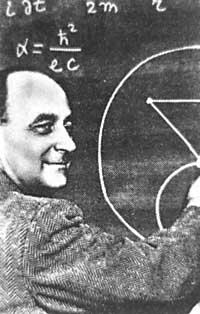Related information
This Italian physicist was born in Rome on 29 September 1901. He completed his doctorate at the University of Pisa in 1922, months before Benito Mussolini came to power.
He subsequently did his research in Germany under the direction of Max Born, but in 1924 he returned to Rome and in 1926 he was appointed professor of physics at the University of Rome.
Since Chadwick discovered the neutron in 1932, Fermi took full care of this subatomic particle. He was very expert in neutral particles and we must not forget that the postulate by Pauli was called “neutrino”.
Neutron was very important because thanks to it many types of nuclear reactions could be made. Lacking electrically charge, the positively charged atomic nucleus did not alter. Therefore, no particle accelerator was needed to bring energy to the neutron. In fact, the less energy they had, the more effects they produced.

Fermi realized that at the beginning of the nuclear reactions the effect of neutrons was greater when they were made to cross the layer of water or paraffin. When a neutron is absorbed by the nucleus of an atom, the new nucleus occasionally emits a beta particle that becomes the next element of greater atomic weight. Fermi came up with bombing uranium with neutrons to get the next element of the periodic system. According to him, in 1934 he achieved a new element called X uranium by applying this system.
Fermi was only partly right, as McMillan showed five years later. When Hahn investigated the problem, Fermi realized it was a more important phenomenon than he thought. However, for the bombing of neutrons and especially for the work done on thermal neutrons, in 1938 he was awarded the Nobel Prize in Physics, before Meitner unveiled the secret of nuclear fission months later.
However, the Fermi family had big problems in Italy. Fermi was anti-fascist and to receive the Nobel Prize he wore no fascist uniform. He also had a Jewish woman. He received the Nobel Prize and from Stockholm Fermi with his family traveled to North America forever. In 1945 he was given American nationality. There he continued to investigate the nuclear fission, especially the reactions of the chains.
When the Manhattan project was created to produce atomic bomb, Fermi was appointed director. His atomic stack triumphed and, on December 2, 1942, he maintained the chain reaction at the University of Chicago, the Atomic Age began.
Two and a half years later, during World War II, atomic bombs were dropped using fission reactions, destroying the Japanese cities of Hiroshima and Nagasaki.
In 1945, Fermi began working at the Nuclear Research Institute and although she participated in the development of the first atomic bomb, the fusion H was contrary to that of Oppenheimer.
In 1954 he died of cancer and the chemical element of atomic number 100 was called “fermio” in homage to the Italian physicist.
Buletina
Bidali zure helbide elektronikoa eta jaso asteroko buletina zure sarrera-ontzian










